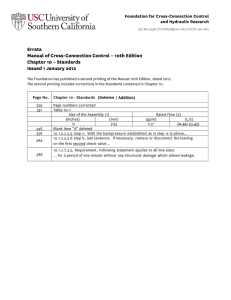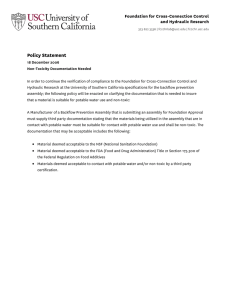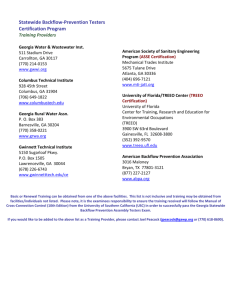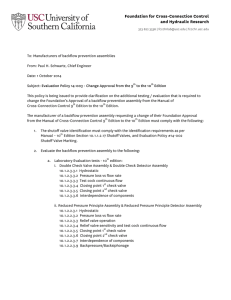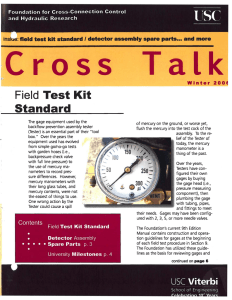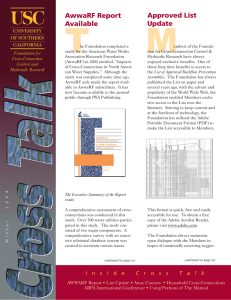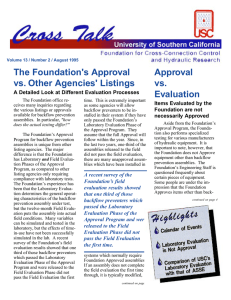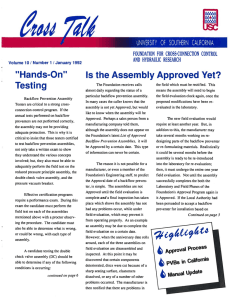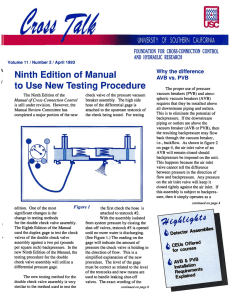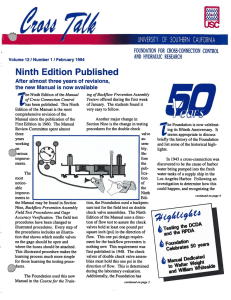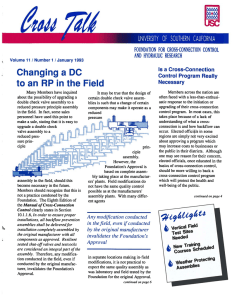A Brief History Installing Double Checks of Backflow
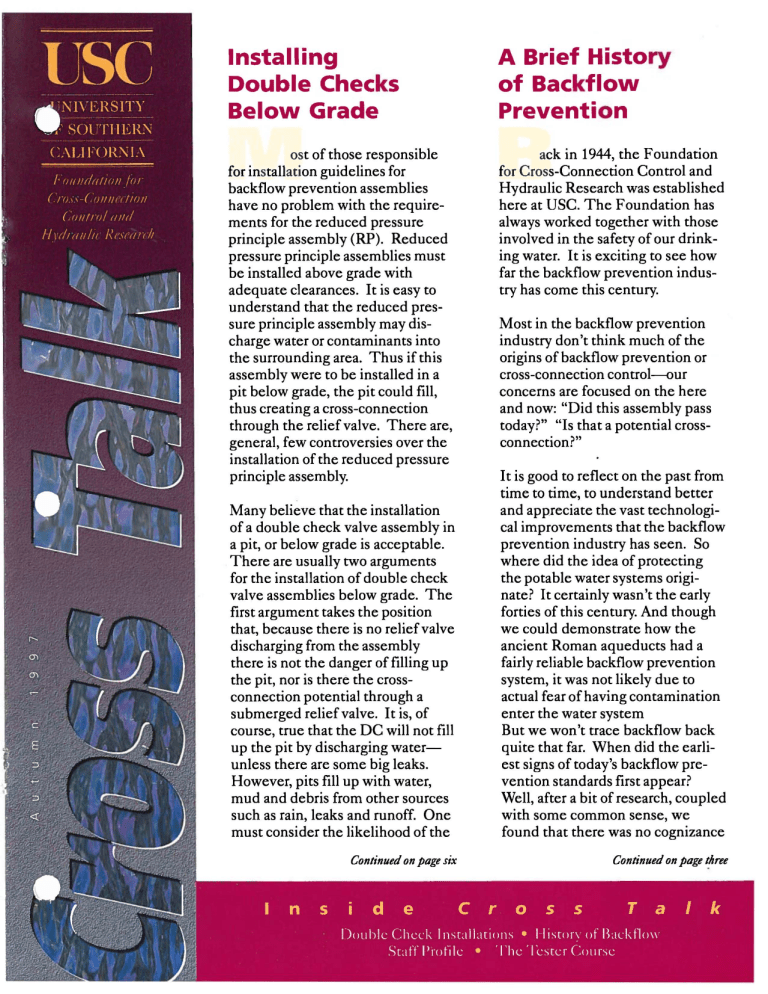
Installing
Double Checks
Below Grade
os t of those responsible for in s tall ati on guidelines for backflow prevention assemblies have no problem with the requirements for the reduced pressure principle assembly (RP). Reduced pressure principle assemblies must be installed above grade with adequate clearances. It is easy to understand that the reduced pressure principle assembly may discharge water or contaminants into the surrounding area. Thus if this assembly were to be installed in a pit below grade, the pit could fill, thus creating a cross-connection through the relief valve. There are, general, few controversies over the installation of the reduced pressure principle assembly.
Many believe that the installation of a double check valve assembly in a pit, or below grade is acceptable.
There are usually two arguments for the installation of double check valve assemblies below grade. The first argument takes the position that, because there is no relief valve discharging from the assembly there is not the danger of filling up the pit, nor is there the crossconnection potential through a submerged relief valve. It is, of course, true that the DC will not fill up the pit by discharging waterunless there are some big leaks.
However, pits fill up with water, mud and debris from other sources such as rain, leaks and runoff. One must consider the likelihood of the
Continued on page six
A Brief History of Backflow
Prevention
a ck in 1944, the Foundation f or Cros s-Connection Control and
Hydraulic Research was established here at USC. The Foundation has always worked together with those involved in the safety of our drinking water. It is exciting to see how far the backflow prevention industry has come this century.
Most in the backflow prevention industry don't think much of the origins of backflow prevention or cross-connection control--Qur concerns are focused on the here and now: "Did this assembly pass today?" "Is that a potential crossconnection?"
It is good to reflect on the past from time to time, to understand better and appreciate the vast technological improvements that the backflow prevention industry has seen. So where did the idea of protecting the potable water systems originate? It certainly wasn't the early forties of this century. And though we could demonstrate how the ancient Roman aqueducts had a fairly reliable backflow prevention system, it was not likely due to actual fear of having contamination enter the water system
But we won't trace backflow back quite that far. When did the earliest signs of today's backflow prevention standards first appear?
Well, after a bit of research, coupled with some common sense, we found that there was no cognizance
Continued on page ~/me
Membership
he Foundation's Membership Program provides many benefits to the M embers of the Foundation. These include: twenty percent discounts on
Founda tion Training courses for any employee of the Member company/ organization, the List of Approved Backflow Prevention Assemblies, printed quarterly, and access to the up-to-the-minute version of the List for those Members with Internet access.
Members are encouraged to call the Foundation with technical questions.
The Foundation's Engineering Staff is available to assist Members with the various aspects of field testing backflow preventers, installing backflow preventers, administering their cross-connection control program.
A-1 Utility & Construction
Automatic Rain Company
Cabaco Incorporated
City of Lafayette
City of Wayne
Commercial
Plumbing, Inc.
Susan Lee D' Aries
DynCorp Tri-Cities
Services, Inc.
Eastman's
Energy & Water
Management
Jay's Baths
Kohler's Sprinkler
Systems
Parsons Engineering
Science
Timothy Shaw
University of Washington
Ventura College
Bookstore
Virginia Department of Health
Contacting the
Foundation
Mailing Address:
Foundation for Cross-
Connection Control and
Hydraulic Research
University of
Southern California
Kaprielian Hall 200
Los Angeles, CA 90089-2531
Q
Phone:
213 740 2032
FAX:
213 740 8399
e-mail:
fccchr@usc.edu
Web Site:
www.usc.edu/deptlfccchr
The Foundation accepts
Purchase Orders via mail or fax and credit card orders
(Visa, MasterCard, Discover) via telephone and the Web .
Cross Talk is published by the Foundation for Cross-Connection Control and Hydraulic Research at the University of Southern California for Foundation Members. Limited additional copies are available to Members upon request. (213) 740-2032 1997 ©University of Southern California.
All rights reserved.
L
A Brief History of Backflow Prevention
-.,ntinued from page one of the need for backflow prevention until rather recently in human history. In fact, it wasn't until the latter half of the 19th century that the first single check assembly was used on some systems in the larger cities. In today's world, the percentage of people hooked into the main potable drinking water system is unimaginably larger than the small, individual well systems in the
1800's. Back then, a hazardous cross-connection would have affected only an extremely small percentage of the population (comparatively).
...,herefore the idea of backflowing contaminants was not much of an issue. Soon, those individual well systems started to become interlinked. The probability oflarge amounts of people being affected by a cross-connections grew proportionally with the population in the new urban areas.
In 1830, New York finally installed its first water main. Interestingly, it took the threat of fire to get the system built, not a desire for the simplification of daily life. Fires were devastating New York because they could not get water from the harbor to the flames fasts enough. In 1835, New York found that the system that it had just installed was still inadequate, due to pressure concerns. The system
1as then put under pressure.
By the 1840's, buildings were beginning to be serviced by this same system, which allowed people to pipe in water to a private residence for the first time without having to go out and fetch it. This was, needless to say, a huge event, and it captured the attention of the public quickly. But it was going to take a hard lesson to bring about the idea of protecting this new system from contaminants.
The ••new••
Foundation Lab, circa 1968.
The idea of protecting the main water supply from debris and contaminants came from the design of early toilets. A single check was first used to try and keep out the sewer smell when a toilet flushed.
This would soon be replaced by a design that resembles the modern trap, and the single check would be translated into a waterline device that could eliminate dirty water from flowing backwards into the mam.
Health officials were becoming aware of the fact that many deadly diseases were spreading through the water system.
But an adequate double check was long overdue when it first appeared. It is hard to imagine that it wasn't until the depression of the
Continued on page seven
What Makes the
USC Tester Course Special?
During this session each student has an actual working assembly in front of him or her. This allow
s
the students
to
perform the field t
e
st procedur
e
s themselves, following th
e
instructor step
Many have asked what makes the
Foundation's Tester Training
Course different that any other training course out there. This article details the specifics about the Foundation's Tester Courses.
The defining attribute of the USC
Tester Course is its solid instruction. Every course is taught by at least two full-time Foundation
Engineering Staff Members. Each of these instructors have taught backflow prevention tester courses for ten to twenty years. During the guided exercises, additional Foundation staff are always available. In order to individualize instruction as much as possible, there is a limit to the number of students at each course. This benefits the attendees by keeping the instructors available to everyone, with plenty of time for questions and individual guidance. There is always, at most, a two to one ratio of students to assemblies. During practice time all of the assemblies which have been covered to date are available. This allows students to practice on the assembly covered that day (like the reduced pressure principle assembly) as well as previously covered assemblies (like the double check valve assembly) which was covered the day before. The Foundation provides plenty of gages from which to chose. The students have their choice of gage so that they can be using the same type of gage they will use when they go back to their place of employment or take a certification exam.
No matter where the course is held, the class format is the same. On
Monday through Thursday, there is a morning classroom session from 8-
Noon. After lunch, the class moves to the wet lab setting for hands on training. The necessary assemblies and other training tools are shipped to the host facility to create an ideal learning facility for the student.
Monday morning consists of a general overview, including hydrau-
' lics, degree of hazard, types of backflow and cross-connections, and types of protection. When the class is moved to the wet lab in the afternoon session, the participants are divided in to two groups to focus the individual attention and instruction. This approach allows the students to become most familiar with the proper procedures for testing in a short amount of time. Each of the smaller groups is given a lecture on the double check valve assembly (DC), and a guided hands-on testing session. The testing procedure is demonstrated using audio-visuals during the lecture; then instructors guide students through the actual testing procedure. During this session each student has an actual working assembly in front of him or her.
This allows the students to perform the field test procedures themselves, following the instructor step
, ,
I' y step. Once knowledge of the basic test is established, troubleshooting assemblies under various operating conditions is covered.
On Tuesday, the morning session consists of a review of the DC (with open discussion and questions), information on jurisdiction and the different responsibilities regarding system protection and internal protection are discussed. Also looked at are the plumbing codes, as well as direct and indirect connections. The afternoon session then covers the reduced pressure principle backflow prevention assembly (RP)-both the procedures for testing a properly operating assembly and then troubleshooting.
'Vednesday starts off with a review
Jf the RP, including open discussion. The rest of the morning is spent looking at the legal responsibilities of a water purveyor and a cross-connection control program.
This session covers questions about the administrative authorities, what approvals are needed, as well as local, state, and national agencies and their regulations. Some time is also given to special topics such as fire sprinkler systems, critical services, and reclaimed water systems. The afternoon session is spent training the students the testing procedure for the pressure vacuum breaker. Again, the format of the instruction is set up so that each student receives individual attention, not a broad overview.
Thursday morning is spent review-
1g each of the assemblies, with an
6 pen discussion. Topics regarding the repair of each assembly are also discussed. The afternoon is fully used for practicing the field test procedures. On this day instructors and assistants are on hand to oversee each student's ability to test, and answer all questions that may come up on an individual basis.
Friday is test day. The written exam is taken at 8:00am, followed immediately by the hands-on portion of the exam, where each student is taken one by one to the wet lab by a proctor. The first proctor tests the student on the first two assemblies, and then another proctor tests the student on the third. Each student is told of the results of the testing prior to leavmg.
The Foundation's goal is to adequately prepare each student to go out into the field confident of the knowledge that is required to properly test any backflow prevention assembly that they may encounter.
Check the schedule on the back cover of
Cross Talk for upcoming Training
Courses.
There is plenty of time for questions and individual guidance
·-
::..;:
,,..
Double Checks
Below Grade
continued from page one
If the test cocks are submerged they, by definition, become a direct crossconnection.
pit becoming filled with water at some point in time. The Foundation staff has seen numerous assemblies installed in pits, which have not only filled with water, but filled with mud and soil.
Even though the pit may fill with water or mud, some would say, there is not a cross-connection across the assembly, since there is no relief valve. It is true that there is no relief valve, however, the test co<-ks must be considered a potential threat if submerged. If the test cocks are submerged they, by definition, become a direct crossconnection. Although our hope is that the test cocks do not leak; they are, in effect, shutoff valves.
Shutoff valves are not considered adequate for backflow protection.
If they were, solenoid valves could replace backflow preventers in many cases. If we create a crossconnection across the test cocks of a double check, we have created a g reater hazard that the hazard which existed in the first place. A double check valve assembly is used when there is only a nonhealth hazard (i.e., pollutant) present. With submerged test cocks a direct cross-connection to a contaminant has been createdthus a greater hazard than the hazard originally present.
The other argument for installing a double check valve assembly in a pit is the fact that such an installation helps protect the assembly against freezing. This is true; the assembly will benefit frum a level of weather protection while installed below grade. However, this does not eliminate the problems mentioned above. The backflow preventer still has the potential to provide a direct cross-connection through the test cocks.
It should be noted that many regions to accept the installation of a double check valve assembly in a pit or vault. Although the
Foundation's recommendation would be to install double check valve assemblies above grade; if
DCs must be installed in pits or vaults, every effort should be made to assure proper drainage.
Field Test
Procedure
Video
Available
./75 minutes
./Testing
./Troubleshooting
./$20.00
for Members
1 f l
J
Fi
T•sti • .
Baclrflo.;
Preventers
Instructional V i dea
r
A Brief History of Backflow Prevention
{
I
1930's that health officials in the US decided it was time to update the plumbing systems of old. This was a massive effort that came about in the aftermath of the famous Chicago amoebic dysentery epidemic during the world's fair in 1933.
What health officials were becoming aware of was the fact that many deadly diseases were spreading through the water system. Polio, for i nstance, was proved to be a waterborne disease, and thus the government decided that it was time to be concerned about crossconnections that could allow backflow, carrying these diseases with it.
In Los Angeles at this time, the
.,opulation was increasing too fast
.ur any reasonable effort to be made to find new sources of water.
Therefore, current water supplies had to be guarded with the notion that if one cross-connection allowed hazardous contaminants into the main, it could effectively shut down most of the city. This happened in
1943, and that was the deciding factor in getting the Foundation established to combat this increasing danger.
In 1944, the Board ofTrustees at the University of Southern California established the Foundation for
Cross-Connection Control Research. The name was later changed to the Foundation for
Cross-Connection Control and
Hydraulic Research. During it's over fifty year history, the Founda-
\on has contributed quite significantly to the backflow prevention industry. Still today there are perhaps more threats than ever to our drinking water supply. Working together with water agencies, health agencies, plumbing authorities, backflow prevention assembly manufacturers and other organizations, the Foundation will continue to serve the industry as long as these threats abound.
Based on the very young age of the backflow prevention industry, it is clear that we are working in a relatively new engineering field. As the population continues to boom, and as current water systems grow, the increased probability of harmful cross-connections prompts the protecting agencies to insure that cross-connection control programs are properly implemented and keeping up with adequate standards.
Sometimes it is nice to go behind the scenes at the Foundation and spotligh one of our employees. In this issue, Mr.
Mtffto Celedon is introduced.
Marco is a11 Associate Civil Engi11eer at the Foundation's Laboratory . Marco started with the Foundation as a student in the Civil Engineering departmmt at USC i11the beginning of
1994.
Marco is native to Southern California, having lived here all his life.
Perhaps that is what makes him so cool.
But most likely his "coolness" can be attributed to the fact that he got his BS in Civil Engineering/rom the University of Southern California-a true
Trojan! Whatever circumstances nurtured Marco'sgcfJrU111CIJ personality, anyone would agree that it is a pleasure to
Since graduating in the spring of 1995, Marco moved into a full time position at the lab, and has also taken some graduate engineering courses. His variety of experience in engineering work makes him a vital asset to the team at the laboratory. Marco is not only working towards his PE, he is a certified welder, and a certified auto technician. He also knows multiple programming languages, certifying him as a computer "genius" as far as most people are concerned. Marco also received a BA in Engineering and a minor in Spanish from St. Mary's Co/lege of California.
Marco is the person responsible for a lithe in-lab testing that goes on daily at the Foundation. In the last issue of Cross Talk, the new data acquisition system was discussed, that helps automate some of the Laboratory tests . Marco developed this system.
Marco also recently started testing a whole new field,far from the logistics of engineering ... marriage. He tied the knot with his beautiful fiancee Bertha on
Saturday, October 11, 199 7. For the honeymoon, Mr. and Mrs. Celedon took a cruise through the Mexican Riviera.
Training Courses
Tester Course
Los Angeles, CA
26-30 January 1998
Los Angeles, CA
4-8 May 1998
Los Angeles, CA
13-1 7 July 1998
Specialist Course
Los Angeles, CA
2-6 February 1998
Incline Village,NV
9-13 March 1998
Los Angeles, CA
20-24 July 1998 usc
UNIVE RSITY
OF SO UT HE RN
CALIFO RN IA
Foundation for Cross-Connection
Control and Hydraulic Research
School of Engineering
Un i ve rs i ty of Southern Ca li forn i a
Kapnella n H a ll 200
L os A n ge l es, Ca l iforn i a 90089 2531
Upcoming Events
Manual Review Committee
Open Meeting
• Los Angeles, CA
13 January 1998
Southern California ABPA
Troubleshooting Workshop
• Long Beach, CA
22 January 1997
First Class
US Postage PAID
University of
Southern California
